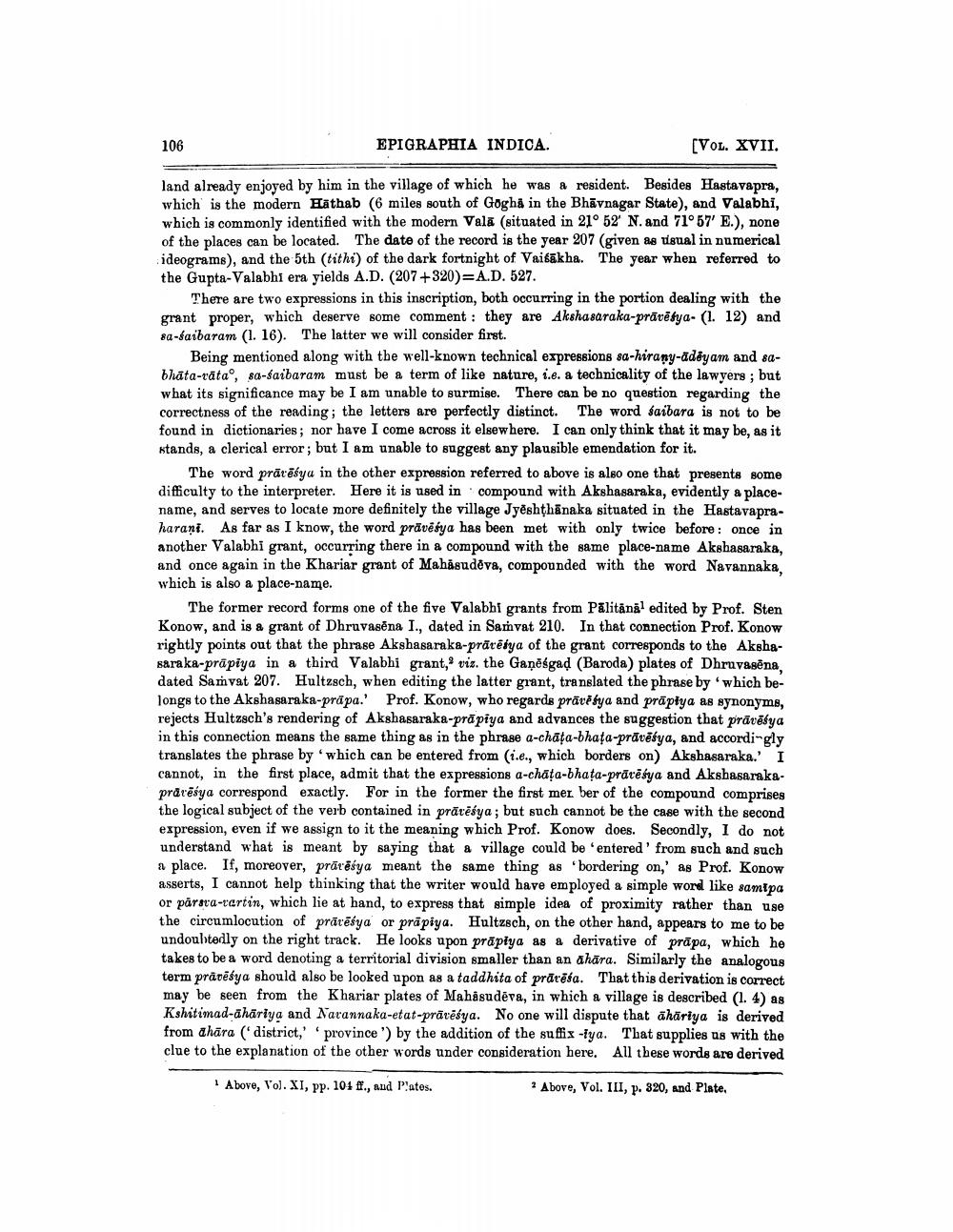________________
106
EPIGRAPHIA INDICA.
[VOL. XVII.
land already enjoyed by him in the village of which he was a resident. Besides Hastavapra, which is the modern Hãthab (6 miles south of Gogha in the Bhāvnagar State), and Valabhi, which is commonly identified with the modern Valā (situated in 21° 52' N. and 71° 57' E.), none of the places can be located. The date of the record is the year 207 (given as usual in numerical ideograms), and the 5th (tithi) of the dark fortnight of Vaišākha. The year when referred to the Gupta-Valabhi era yields A.D. (207+320)=A.D. 527.
There are two expressions in this inscription, both occurring in the portion dealing with the grant proper, which deserve some comment : they are Akshasaraka-prārēbya- (1. 12) and 8a-faibaram (1. 16). The latter we will consider first.
Being mentioned along with the well-known technical expressions sa-hirany-adeyam and sabhata-rata, 80-saibaram must be a term of like nature, i.e. a technicality of the lawyers; but what its significance may be I am unable to surmise. There can be no question regarding the correctness of the reading; the letters are perfectly distinct. The word saibara is not to be found in dictionaries; nor have I come across it elsewhere. I can only think that it may be, as it stands, a clerical error; but I am unable to suggest any plausible emendation for it.
The word prātēsya in the other expression referred to above is also one that presents some difficulty to the interpreter. Here it is used in compound with Akshasaraka, evidently a placename, and serves to locate more definitely the village Jyështhānaka situated in the Hastavapraharani. As far as I know, the word prāvēsya has been met with only twice before : once in another Valabhi grant, occurring there in a compound with the same place-name Akshasaraka, and once again in the Khariar grant of Mahäsudeva, compounded with the word Navannaka, which is also a place-name.
The former record forms one of the five Valabhi grants from Palitanäl edited by Prof. Sten Konow, and is a grant of Dhruvasēna I., dated in Samvat 210. In that connection Prof. Konow rightly points out that the phrase Akshasaraka-prārēsya of the grant corresponds to the Akshasaraka-prāpiya in a third Valabhi grant, viz. the Gaņēégad (Baroda) plates of Dhruvagēna, dated Samvat 207. Hultzsch, when editing the latter grant, translated the phrase by which belongs to the Akshasaraka-prapa. Prof. Konow, who regards prāvēsya and präpiya as synonyms, rejects Hultzsch's rendering of Akshasaraka-prapiya and advances the suggestion that prāvēsya in this connection means the same thing as in the phrase a-châta-bhata-prāvēsya, and accordingly translates the phrase by which can be entered from (i.e., which borders on) Akshasaraka. I cannot, in the first place, admit that the expressions a-chata-bhata-prāvēsya and Aksbasarakaprarēsya correspond exactly. For in the former the first mer ber of the compound comprises the logical subject of the verb contained in prāvēśya; but such cannot be the case with the second expression, even if we assign to it the meaning which Prof. Konow does. Secondly, I do not understand what is meant by saying that a village could be entered' from such and such a place. If, moreover, prātēsya meant the same thing as "bordering on,' as Prof. Konow asserts, I cannot help thinking that the writer would have employed a simple worel like samipa or parsra-tartin, which lie at hand, to express that simple idea of proximity rather than use the circumlocution of prārēsya or prāpiya. Hultzsch, on the other hand, appears to me to be undoubtedly on the right track. He looks upon prāpiya as a derivative of prāpa, which he takes to be a word denoting a territorial division smaller than an ahāra. Similarly the analogous term prävēsya should also be looked upon as a taddhita of prarēša. That this derivation is correct may be seen from the Khariar plates of Mahasudeva, in which a village is described (1. 4) as Kshitimad-ähäriya and Narannaka-etat-prāvēsya. No one will dispute that ahāriya is derived from ahāra (district, province ') by the addition of the suffix -iya. That supplies us with the clue to the explanation of the other words under consideration here. All these words are derived
Above, Vol. XI, pp. 101 ff., and Pates.
2 Above, Vol. III, p. 320, and Plate,




